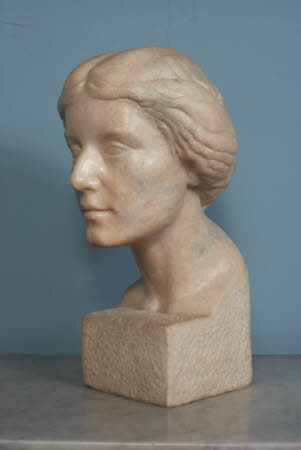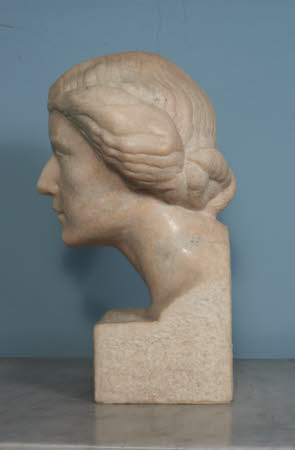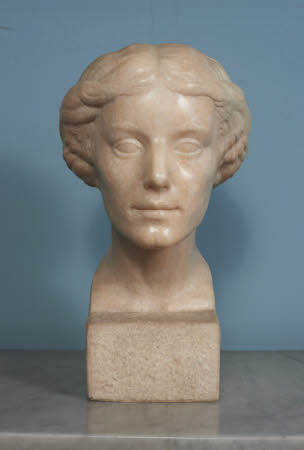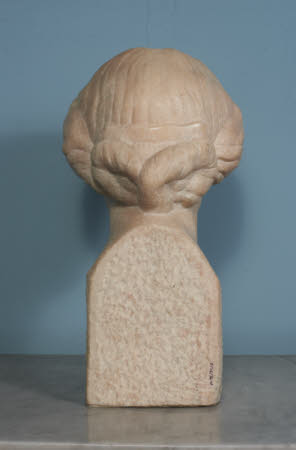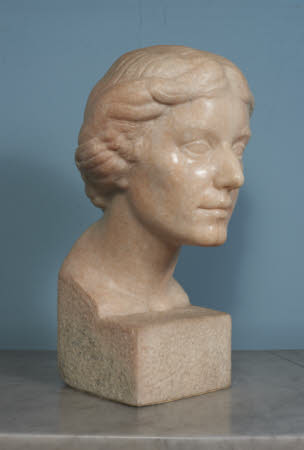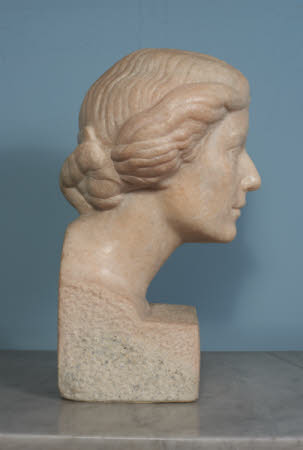Edith Teresa Hulton, Lady Berwick (1890-1972)
Antonio Maraini (1886-1963)
Category
Art / Sculpture
Date
1920 - 1921
Materials
Alabaster
Measurements
395 mm (Height)
Place of origin
Florence
Order this imageCollection
Attingham Park, Shropshire
NT 609432
Summary
An alabaster portrait bust of Edith Teresa Hulton, the 8th Lady Berwick of Attingham Park (1890-1972) by Antonio Maraini (Rome 1886 - Florence 1963). The mottled off-white bust depicts her head and neck and is set on a square base. Lady Berwick is facing to the front and has her long hair in a centre parting and gathered to the nape of her neck and held in place with a comb. The bust was sculpted in Florence in 1920 or 1921. Edith Teresa Hulton was the daughter of the artist William Stokes Hulton (1852-1921) and Costanza Mazini (1863–1939). She married Thomas Henry Noel-Hill, 8th Baron Berwick of Attingham (1877-1947) on 30 June 1919. Letters in the Attingham archive detail the creation of the bust by Antonio Maraini, who referred to as ‘Nello’ by his family and friends. The letters cover the period between July 1920 and August 1949. On 13th October 1920, Maraini’s wife, Yoï, wrote that she had watched the bust being turned into a cast. In the same letter she explained that Maraini was trying to source rose marble but white marble was to be used instead. Rose marble had been found by January 1921 and Maraini’s wife suggested that a “Teresabustparty” should be held. In March 1921 she commented that the pink marble found by Nello in Milan contained a flaw and he had then gone on to source a piece in Rome. On 29th September 1921 she wrote: “We got the pink marble for you and didn’t like it. We have sent for another piece and hope now to be successful at last. It is very difficult to get the right shade and without flaw. The bust has been very much admired even in that horrible white stuff and I must say every time I see it I get a terrible longing to see your pretty blue eyes again.” The bust obviously received a mixed reception. On 17th June 1922 Maraini’s wife wrote: “Your bust is being much liked. Did Gioconda really find it good of you or was she only polite? Miss Mansfield and Marchesa Montagliari love it. I can’t quite love it, because I miss the blue of your eyes. But of course that is silly of me.” Marie Watkins, Teresa’s friend from her wartime work during the First World War, was not too keen on the bust. On 17th October 1924 she wrote: "I cannot bear your bust by Maraini and am wondering how I am to be polite about it when I see him. It misses everything." In January 1925 the bust was sent to Teresa’s mother’s home in Venice after having been exhibited at the Venice Biennale in 1924. From Venice, the bust may have then been sent on to Attingham, Shropshire later in 1925. Maraini’s wife and her children visited Attingham four times between 1924 and 1935. In August 1949 Lady Berwick was visited by Arnolfo Fezzuoli and Giuliano Pellegrini, an Italian author, to see her and the Maraini bust. Maraini’s son, Fosco and his daughter, Toni (Antonella), an art historian, signed the Attingham visitor book in February 1961. 2017 note: This bust was previously attributed to Mario Marini (Pistoia 1901 - Viareggio 1980) but this was corrected after the new information above came to light as part of the Attingham Archive Project.
Provenance
Lady Berwick collection; bequeathed to the National Trust by Edith Teresa Hulton, Lady Berwick (1890-1972).
Makers and roles
Antonio Maraini (1886-1963), sculptor previously catalogued as attributed to Marino Marini (Pistoia 1901 - Viareggio 1980), sculptor
References
Waterson 1980 Merlin Waterson, 'Lady Berwick, Attingham and Italy', National Trust Studies 1981, 1980, pp 43-68
